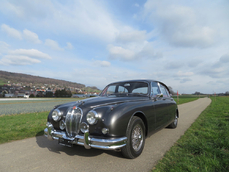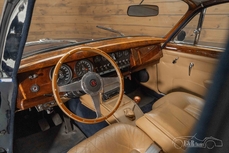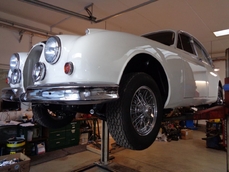Jaguar Mk2 3.8 Saloon 1963
Allgemeine Beschreibung :
From its earliest days as S.S. Cars, luxurious and sporty saloon cars have sustained Jaguar through its highs and lows. In the mid-1950s, Jaguar was savoring the accomplishments of the XK sports cars and world-beating C-Type and D-Type sports racers. They even enjoyed surprising success with the massive MkVII and MkIX in British Saloon Car racing in the hands of Sir Stirling Moss, Roy Salvadori, and others. But Jaguar saw an opportunity to appeal to a broader market with a smaller, more compact luxury saloon that shared a common bloodline with their sports cars. The new mid-sized sedan debuted in 1955, built on Jaguar’s first-ever road-going monocoque chassis and powered by 2.4 or 3.4-liter versions of the XK twin-cam inline six. The curvaceous body styling was influenced by the XK sports cars, and the cabin was trimmed with vast swaths of leather and wood.
Further refinements to the shape and mechanical spec brought the Mark 2 of 1959, which featured a more expansive glasshouse and a host of mechanical improvements including the addition of the hot 3.8-liter engine shared with the XK150 and the E-Type. The Mark 2 was an overnight motorsport sensation, proving to be a formidable competitor in rallying and circuit racing. The Mark 2 is considered by many to be the father of the modern sports sedan, and one blast in the gutsy 3.8 makes it very easy to see why. The Mark 2 and its derivatives would remain a cornerstone of Jaguar sales until 1969 when the XJ6 consolidated all of Jaguar’s four-door models into one single line.
This outstanding Mark 2 3.8 Saloon is a lifelong black-plate California car that has had only three owners over its 55-year life. Equipped from new with the 3.8-liter engine, four-speed manual gearbox, and factory overdrive, it includes the original dealer invoice and extensive records of its restoration and maintenance. According to the Jaguar Daimler Heritage Trust Certificate, it was originally delivered via British Cars of Burlingame to Dr. Robert J. Sells of Hillsborough, California. The original invoice shows Dr. Sells traded his 1955 Buick for a $200 credit on the $4,177 Jaguar. For the next 25 years, Dr. Sells cherished his Mark 2, driving it all across Northern California and keeping it in excellent working order. On November 18, 1989, he sold his beloved Jaguar to Mr. & Mrs. John Splittorf of Gilroy, California.
In the hands of the Splittorfs, the Jaguar was treated to a comprehensive, two-year restoration with the goal of creating a high-level concours competitor. During the process, the color was changed from Golden Sand to Old English White, and the interior trimmed in Biscuit leather. An extensive history file includes photographs that document the restoration and reveal the car to be incredibly solid and clean when the project commenced. Photos also show the original engine and overdrive were rebuilt, and in the process, the odometer was zeroed. With meticulous preparation, the Mark 2 was shown in November 1991 at the JCNA Concours in Tucson, Arizona, where it scored an incredible 99.67 points in a highly competitive field. It would be counted among the best Jaguar saloons in America with its stunning and authentic presentation.
Inside the accompanying file are numerous receipts as well as a large stack of California registration slips from Mr. Splittorf’s time with the Mark 2. He and his wife enjoyed the Jaguar for 27 years, accruing most of the car’s current 14,600 miles along the way. The car’s most recent owner, also from California, completed two entries in the Going to the Sun Rally across Montana. He specifically chose the Mark 2 for its performance as well as its practicality, which allowed his wife and son to accompany him on the adventure.
Today, the presentation is excellent and reflective of the award-winning restoration. In the time since it was completed, the paint has remained glossy and attractive, with the finish now showing a few minor touch-ups and slight paint shrinking in select areas. The body remains beautifully straight and the doors open and shut with satisfying precision. Likewise, the chrome shows some light hazing and polish marks in places, yet remain consistent and in fine overall condition. The car sits beautifully on its chrome knock-off wire wheels shod with whitewall radial tires.
The interior is outstanding, with biscuit leather seats, matching door cards and correct-type wool carpet. It remains remarkably well-preserved since its time as a show car, with supple leather showing only the slightest creasing from use. Instruments and switchgear are excellent, set in a satin-finish wood dash that, along with the rest of the wood trim, has mellowed nicely since its restoration. Color-keyed seatbelts are carefully integrated, and a very rare and desirable three-spoke Derrington steering wheel adds a sporting touch. The boot is trimmed with correct materials and includes the original jack and toolkit, which fits neatly inside the spare wheel. The sale will also include the original owner’s books and factory parts and service manuals.
Jaguar’s iconic XK inline six is beautifully presented under the bonnet. Correct finishes, hardware, and fasteners remain in very good order, showing only some slight wear from recent road use. The block and head numbers match and correspond with the firewall tag and Heritage Certificate. At the time of restoration, the engine was mated with a very desirable all-synchro four-speed gearbox from a 4.2 liter-equipped car, which is mated with the original and functional overdrive unit to create the ultimate Jaguar driving experience.
The high-quality restoration still shines through on this wonderful Mark 2. It has been expertly maintained by its passionate owners and has proven its worth both on the concours field and on-road events. It is equipped from new in the most desirable specification and is ready for its next long-term owner to enjoy the distinct pleasure of driving a properly sorted Mark 2 – with its unique combination of vintage appeal, luxurious accommodations, and outstanding performance.
https://hymanltd.com/vehicles/6271
1963 Jaguar Mk2 3.8 Saloon is listed verkauft on ClassicDigest in St. Louis by Mark Hyman for $69500.
Fakten der Auto
Karosserietyp : Auto Marke : Jaguar Modell : Mk2 Ausführung : 3.8 Saloon Hubraum : 0.0 Modelljahr : 1963 Karosstyp : Sedan Lage : Missouri
Verkauft
Angaben Zum Verkäufer
Verkauft
People who viewed this Jaguar Mk2 also viewed similar Jaguar listed at ClassicDigest
Other cars listed for sale by this dealer
über Jaguar
Ah, die Geschichte von Jaguar, von seinen Anfängen als SS Cars Ltd. bis hin zum Höhepunkt mit dem D-Typ und der Straßenversion des ikonischen E-Typs. An dieser Erzählung haftet etwas zutiefst Britisches, und ich werde sie erzählen, wie es ein britischer Journalist tun würde.Die Anfänge:
Unsere Reise in die Welt von Jaguar beginnt in den 1930er Jahren, als ein Unternehmen namens SS Cars Ltd. auftauchte. Trotz des unglücklichen Zufalls ihrer Initialen, die mit den aufkommenden politischen Spannungen in Europa zusammenfielen, begannen sie, stilvolle und leistungsorientierte Autos herzustellen. Der SS 100, der 1936 eingeführt wurde, war ein Symbol für Eleganz und Geschwindigkeit und legte den Grundstein für das, was Jaguar werden sollte.
Die Geburt von Jaguar:
Als der Schatten des Zweiten Weltkriegs näher rückte, entschied sich SS Cars Ltd. klugerweise, sich von den SS-Initialen zu distanzieren. So wurden sie 1945 offiziell zu Jaguar Cars Ltd., ein Name, der bald für britischen Luxus und Leistung stehen würde.
Die XK-Serie:
Die Nachkriegszeit von Jaguar brachte uns den XK 120, eine wahre Sensation im Jahr 1948. Mit seinem schlanken Design und einem leistungsstarken 3,4-Liter-Sechszylindermotor wurde er zum schnellsten Serienauto der Welt. Der XK 120 war die Blaupause für das, was kommen würde - Jaguars, die Stil mit Geschwindigkeit auf einzigartig britische Weise verbanden.
Die Dominanz des D-Typs:
Dann kam der D-Typ, eine wahre Rennlegende. 1954 eingeführt, gewann er in den 1950er Jahren dreimal Le Mans und zeigte die technische Kompetenz von Jaguar. Mit seiner innovativen Monocoque-Konstruktion und der ikonischen Finne hinten war der D-Typ der Höhepunkt von Jaguars Motorsporterfolgen.
Das Auftauchen des E-Typs:
Aber der wahre Wendepunkt kam 1961 mit der Einführung des E-Typs, oft von Enzo Ferrari als "das schönste Auto, das je gebaut wurde" bezeichnet. Seine lange Motorhaube, die geschwungene Karosserie und ein 3,8-Liter-Motor, der atemberaubende Leistung lieferte, machten ihn sofort zu einem Klassiker. Der E-Typ war nicht nur ein Auto; er war ein Kunstwerk auf Rädern und konnte auf der Straße 150 Meilen pro Stunde erreichen.
Straßen- und Rennsporterfolge:
Die Schönheit des E-Typs wurde durch seine Leistung auf der Rennstrecke unterstrichen. Die leichten E-Typen waren bei verschiedenen Rennveranstaltungen besonders erfolgreich und festigten den Ruf von Jaguar als eine Kraft, mit der man im Motorsport rechnen musste.
Das Zeitalter der Raffinesse:
Je tiefer wir in die Geschichte von Jaguar eintauchen, desto mehr erkennen wir, dass die 1950er und 1960er Jahre ein Zeitalter der Raffinesse und Expansion waren. Neben dem großartigen D-Typ und dem ikonischen Aufstieg des E-Typs führte Jaguar Modelle ein, die seinen Ruf für Luxus und Leistung weiter festigten.
Der MK2:
Ende der 1950er Jahre stellte Jaguar den MK2 vor, eine Sportlimousine, die Eleganz mit Leistung vereinte. Diese elegante viertürige Limousine war sowohl bei Bankräubern als auch bei der Polizei aufgrund ihrer außergewöhnlichen Geschwindigkeit und Handhabung beliebt. Der MK2 war ein Symbol für Jaguars Fähigkeit, Raffinesse mit Leistung zu verbinden und hatte auch eine erfolgreiche Rennkarriere.
Der XJ6:
Springen wir ins Jahr 1968, als Jaguar ein Auto auf den Markt brachte, das Jahrzehnte lang Luxuslimousinen definieren würde - den XJ6. Es war ein Meisterwerk der Ingenieurkunst und des Designs, mit einem sanften Reihensechszylindermotor, unabhängiger Hinterachse und einem geräumigen, wunderschön ausgestatteten Innenraum. Der XJ6 war ein Symbol britischer Eleganz und bot eine so sanfte Fahrt, dass es schien, als würde er förmlich über die Straße gleiten. Er wurde zum Flaggschiffmodell für Jaguar und setzte den Maßstab für Luxuslimousinen und zeigte ein Maß an Raffinesse, das die Konkurrenz staunen ließ.
Die Verschmelzung von Klassik und Moderne:
Während der MK2 und der XJ6 die Evolution der Limousinen von Jaguar repräsentierten, bewahrten sie das Engagement der Marke für Leistung und Luxus. Diese Autos gehörten nicht nur auf die Rennstrecke; sie fühlten sich genauso wohl auf den Prachtstraßen wie auf einer entspannten Fahrt durch die englische Landschaft.
Die Herausforderungen des Wandels:
Dennoch sah sich Jaguar mit dem Eintritt der 1970er Jahre, wie viele britische Automobilhersteller, finanziellen Herausforderungen und Veränderungen in der Eigentümerschaft gegenüber. Die Ära von British Leyland brachte sowohl Chancen als auch Schwierigkeiten mit sich, während die Marke durch verschiedene Fusionen und Übergänge navigierte.
Das Erbe des MK2 und des XJ6, zusammen mit dem D-Typ und dem E-Typ, definiert Jaguar weiterhin als einen Hersteller, der zeitlose Eleganz mit einer Leistungsstärke vereint. Diese klassischen Modelle, ob sie über kurvige Straßen gefahren oder als Sammlerschätze geparkt werden, dienen als Zeugnis für die anhaltende Präsenz von Jaguar in der Welt der automobilen Exzellenz.
Die Jaguar-Geschichte, von ihren Anfängen als SS Cars Ltd. bis zur Schaffung von Automobilikonen wie dem E-Typ, dem MK2 und dem XJ6, ist eine Reise, die das Wesen des britischen Automobilbaus widerspiegelt - eine Mischung aus Luxus, Leistung und Stil, die nach wie vor Enthusiasten und Kenner gleichermaßen fasziniert.











